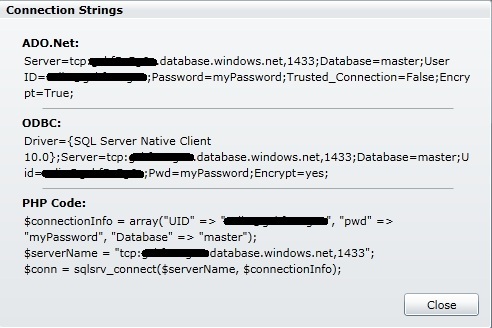Using SQL Azure with Enterprise Server for .NET
SQL Azure databases can host both CICS regions and VSAM data files. A CICS system deployed either on-premise by an Enterprise Option product installation, or off-premise by an Azure Hosted Service can access a SQL Azure region and VSAM file databases. Performance when accessing SQL Azure on-premise is significantly slower than accessing it directly from an Azure Hosted Service where the Azure Hosted Service and SQL Azure database(s) are hosted in the same data center.
By default, Enterprise Option uses Windows authentication (SSPI), using the logged in user's credentials to access SQL Server databases. However, connecting to a SQL Azure database requires a specially formatted connection string that includes your SQL Azure database server name, user name and password. Do the following to determine the connection string for your master database.
By default, the administration tool wizard will create connection strings automatically, but if you want to override the defaults, follow these steps to obtain the database connection strings:
- Login to the Azure Management portal and click
Db icon
in the left-hand pane.
The SQL databases screen will be displayed.
- Select the database of interest.
- Under the quick glance section is an information button "Show connection strings. Click this.
- The Connection Strings dialog box appears.
- Copy the connection string displayed under ADO.Net and then click
Close to close the dialog box.

The connection string is similar to the following:
Server=tcp:[servername].database.windows.net; Database=master; User ID=[username]@[servername]; Password=[userpassword]; Trusted_Connection=False; Encrypt=True;where:- [servername] is the name of your SQL Azure database server (for example iwek9v4j6a)
- [username] is your SQL Azure user name and [userpassword] is your SQL Azure password
The connection string for each of your SQL Azure databases has the same format except with master replaced by the appropriate database name.